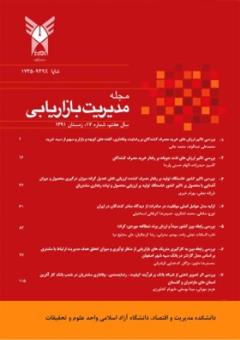طراحی مدل بازاریابی عصبی با رویکرد نگرش رفتار مصرف کننده در صنعت بانکداری
محورهای موضوعی : مدیریت بازاریابی
مریم خضری
1
,
یزدان شیرمحمدی
2
*
![]() ,
علیرضا میرعرب بیگی
3
,
علیرضا میرعرب بیگی
3
1 - گروه مدیریت بازرگانی، واحد رودهن، دانشگاه آزاد اسلامی، رودهن، ایران
2 - گروه مدیریت بازرگانی، واحد تهران، دانشگاه پیام، تهران، ایران،
3 - گروه مدیریت بازرگانی، واحد رودهن، دانشگاه آزاد اسلامی، رودهن، ایران
کلید واژه: خودناهمخوانی, رفتار مصرفکنندگان, کالاهای لوکس. ,
چکیده مقاله :
هدف: محققین از تلفیق روانشناسی و بازاریابی روش جدیدی بنام بازاریابی عصبی را ابداع کردند که در آن به تاثیر گذاری غیر مستقیم و پایدار بر ذهن مشتری تاکید میشود. هدف پژوهش حاضر طراحی مدل مناسب بازاریابی عصبی با رویکرد رفتار مصرف کننده درصنعت بانکداری است. روش: پژوهش حاضر از نظر ماهیت پژوهش، کاربردی؛ نحوه و روش پژوهش، کیفی؛ رویکرد پژوهش، استقرایی؛ پارادایم حاکم بر پژوهش، تفسیری؛ استراتژی پژوهش، تئوری داده بنیاد و منبع گردآوری داده¬ها شامل مطالعه مبانی نظری و مصاحبه می باشد. جامعه آماری پژوهش در 2 گروه شامل، مدیران بانکهای دولتی و خصوصی، اساتید هیئت علمی دانشگاهی حوزه مدیریت و بازاریابی دانشگاههای دولتی و آزاد که با استفاده از روش نمونه گیری غیراحتمالی هدفمند گلوله برفی، نظرات 20نفر از آنها طی مصاحبه نیمه ساختاریافته تا رسیدن به حد اشباع نظری، جمع آوری گردید. از مقبولیّت، انتقال پذیری و تأیید پذیری جهت برآورد روایی و از روش سازگاری درونی (ضریب آلفای کرونباخ=0.91) برای سنجش پایایی استفاده شده است. روش تحلیل داده ها نیز با انجام سه مرحله کدگذاری شامل کدگذاری باز، محوری و انتخابی انجام پذیرفت. یافته ها: یافته های پژوهش نشان داد که تعداد 245 کد نهایی از مرحله کدگذاری باز استخراج گردید. در مرحله کدگذاری محوری در شرایط علی تعداد 6 مقوله فرعی و 62 کد، شرایط زمینه ای تعداد 5 مقوله فرعی و 41 کد؛ عوامل مداخله گر تعداد 6 مقوله فرعی و 35 کد؛ راهبردها تعداد 9 مقوله فرعی و 58 کد و پیامدها تعداد 10 مقوله فرعی و 63 کد شناسایی شدند. نتیجه گیری: در این تحقیق مدل بازاریابی عصبی با رویکرد نگرش رفتار مصرف کننده در صنعت بانکداری طراحی شده است که انتظار می رود، مورد کاربرد مدیران بانک ها قرار بگیرد.
Purpose By combining psychology and marketing, researchers invented a new method called neuromarketing, in which indirect and sustainable influence on the customer's mind is emphasized. The aim of the current research is to design a suitable neuromarketing model with a consumer behavior approach in the banking industry. Method: The current research is practical in terms of the nature of the research; The manner and method of research, qualitative; research approach, inductive; The ruling paradigm of research is interpretive; The research strategy, foundational data theory and source of data collection include the study of theoretical foundations and interviews. The statistical population of the research consists of 2 groups, managers of public and private banks, academic faculty professors in the field of management and marketing of public and independent universities, who, using the non-probability purposeful snowball sampling method, the opinions of 20 of them during semi-structured interviews until reaching The theoretical saturation limit was collected. Acceptability, transferability and verifiability were used to estimate validity and internal consistency method (Cronbach's alpha coefficient = 0.91) was used to measure reliability. The method of data analysis was done by performing three stages of coding including open, central and selective coding. Findings: The research findings showed that 245 final codes were extracted from the open coding stage. In the central coding stage, there are 6 sub-categories and 62 codes in causal conditions, 5 sub-categories and 41 codes in contextual conditions; Intervening factors number of 6 subcategories and 35 codes; Strategies, 9 subcategories and 58 codes, and outcomes, 10 subcategories and 63 codes were identified. Conclusion: In this research, the neuromarketing model has been designed with the approach of consumer behavior in the banking industry, which is expected to be used by bank managers.

